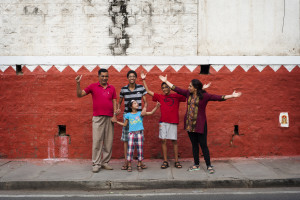Lessons from the Ugly Indian
“I have been convinced more than ever that human nature is much the same, no matter under what clime it flourishes, and that if you approached people with trust and affection you would have ten-fold trust and thousand-fold affection returned to you.” -M. K. Gandhi
 My friend Ashish swerved through traffic on Church Street, one of the busiest roads in Bangalore. I leaned out of the window to feel the night air. Women wore fluorescent salwar kameezes; neon-lit rickshaw drivers negotiated prices; businessmen ate dosas at a dhaba. I’d seen this before. What I hadn’t seen was the massive swirl of colors on a wall we passed.
My friend Ashish swerved through traffic on Church Street, one of the busiest roads in Bangalore. I leaned out of the window to feel the night air. Women wore fluorescent salwar kameezes; neon-lit rickshaw drivers negotiated prices; businessmen ate dosas at a dhaba. I’d seen this before. What I hadn’t seen was the massive swirl of colors on a wall we passed.
“Woah, what was that?” I asked.
“The mural?” said Maithili, Ashish’s wife.
“Yeah. Was it commissioned? I haven’t seen that kind of art in India.”
Maithili turned in the passenger seat. “It’s the Ugly Indian.”
I made a puzzled expression.
“It’s a neighborhood cleanup group.”
Ashish wedged his car into a lucky parking spot. “They use everyday volunteers and clean up the dirtiest parts of the city. You should see how they are transforming Bangalore.”
***

Before
A white-masked man introduced as Anamik Nagrik stood on the TEDxBangalore stage on Oct 27, 2014 to talk about the Ugly Indian. Anonymity was essential. “I’m a proud Indian,” he said, “but I have one problem with my country…why is India so filthy?”

After
There is no denying India’s reputation as dirty. Indrajit Hazra, in the February 2015 Indian Times, wrote that despite India’s clean homes, “We’re quite proud of being filthy” in public spaces. “Cleanliness, to us, bears an elitist tag.”
Anamik Nagrik said that people assume their neighbors are at fault and ignore dustbins, allowing trash to heap up in front of the useless receptacles. “Only we can save us from ourselves. Let’s fix this in an Indian way.”
The Ugly Indian started in 2010 when a bold community experimented with a soiled wall. They painted a red band at the bottom and planted flowers in front. To their surprise, the wall stayed clean. Since then the movement has sparked interest all over India. More than 400 “spotfixes” have been cleaned up in Bangalore. Sixty other cities in India have also started Ugly Indian cleanups. Organizations like Youth for Change have adopted similar models. Even other countries like Bahrain, Sri Lanka, and Malaysia are emulating the movement and embracing the positive change.
The Ugly Indian’s name is deliberate. Embedded in the self-conscious name is both a personal acceptance of a condition, and the responsibility to change it. The volunteers responsible for this transformation are ordinary people. To ensure the mission focuses on the work and not the individuals, a policy of strict anonymity is encouraged. Their motto, “Kaam Chaalu Mooh Bandh” in Hindi, and “Baayi Mucchu Kelsa Hacchu” in Kannada, means “Just Work, No Talk” or “Stop Speaking, Start Doing.” The focus is on the results, rather than who achieves them.
***
I waited beside a mountain of rubbish for a cab to take me to an Ugly Indian spotfix. A crooked sign on a nearby tree read: “Please do not throw garbage here.” I breathed through my mouth to avoid inhaling the stench of wadded up diapers, rotten fruit, used sanitary napkins, charred plastic bags, and broken glass bottles.
My husband, Austin, stood with me. He was confused. “You don’t know this guy’s name?”
“The group is into anonymity.” I folded my arms and pretended I wasn’t nervous.
He raised an eyebrow. “Are you meeting him at a public address?”
“Of course.” I flashed an assuring smile, but I didn’t feel so assured. The Mystery Man who had responded from the Ugly Indian email address I had located from a Facebook page gave me the address. He called at my request to meet and discuss the movement that had preoccupied me.
The cab pulled up. I rattled directions to the driver and said goodbye to Austin.
“Let me know when you get there,” he said, passing me our Nokia flip phone. I waved as we pulled away.
 I realized that this was the first time I’d been alone in a cab since we’d arrived in India two months earlier. This wouldn’t have fazed me in many places, but India and I had baggage. Years earlier, I’d spent a few months in the north doing field research with a refugee population. When I returned to the States I was a mess. I wouldn’t get out of bed. I skipped classes. My grades slipped. My long-term boyfriend broke up with me. No one seemed to understand what I’d seen.
I realized that this was the first time I’d been alone in a cab since we’d arrived in India two months earlier. This wouldn’t have fazed me in many places, but India and I had baggage. Years earlier, I’d spent a few months in the north doing field research with a refugee population. When I returned to the States I was a mess. I wouldn’t get out of bed. I skipped classes. My grades slipped. My long-term boyfriend broke up with me. No one seemed to understand what I’d seen.
India haunted me. I never got over the pungent smells, the image of burning corpses with melting faces in Varanasi, or the terror I’d experienced being stalked by a group of rowdy men on a hike. Despite my anthropology training and ability to suspend judgment and uphold cultural relativity, the negatives consumed me and distorted my judgements. It was hard to remember that not all Indian men were the ones who chased me through the trees shouting sexual harassments and threats. Never in my wildest nightmares did I think I would return to India.
“Banashankari, Madam?” said the driver.
 “Yes, that’s the neighborhood.” I fidgeted with my backpack strap and realized I had forgotten to negotiate the price of the cab before I’d gotten in. I burned with guilt at my assumption that the man would rip me off. Sweat dripped down my back. I wiped my forehead with my dupatta and rolled down the window. We passed colorful murals of green pastoral landscapes with people working with parrots and deer. I knew deep down that I’d come back to India because I was sick of my suspicions and wanted restitution. There was beauty that I had missed, buried in a deep, internal vault. It was time to free it.
“Yes, that’s the neighborhood.” I fidgeted with my backpack strap and realized I had forgotten to negotiate the price of the cab before I’d gotten in. I burned with guilt at my assumption that the man would rip me off. Sweat dripped down my back. I wiped my forehead with my dupatta and rolled down the window. We passed colorful murals of green pastoral landscapes with people working with parrots and deer. I knew deep down that I’d come back to India because I was sick of my suspicions and wanted restitution. There was beauty that I had missed, buried in a deep, internal vault. It was time to free it.
We turned a corner. A wall painted white with a rust-red fence pattern emerged on the left, the Ugly Indian’s iconic branding.
“First Cross Street, Madam,” said the driver. He stopped behind the BSM College of Engineering and pointed me in the direction of my destination. He asked an especially fair price. I thanked him and pocketed my assumptions.
***
A young man in a red-checkered collared shirt pulled up on a blue motorcycle. He pulled off his helmet. “Are you Rachel?”
“That’s me.” He had to be Mystery Man.
 We shook hands as he reminded me about confidentiality. “We’re going to see a cleanup spot, or as we call it, a ‘spotfix,’ from last weekend.”
We shook hands as he reminded me about confidentiality. “We’re going to see a cleanup spot, or as we call it, a ‘spotfix,’ from last weekend.”
Mystery Man wasn’t much older than me, and had thick black hair and pale green eyes. He wouldn’t tell me about his involvement in the organization, but his flawless English and knowledge of the Ugly Indian told me he was educated and deeply involved. He, unlike many people who now live in Bangalore, was born and raised here.
We walked towards the long painted wall I’d first noticed. “In addition to the prestigious engineering college nearby, we’re close to two famous temples,” he said with pride. The sacred, popular Basavanagudi (the Bull Temple) and Gavi Gangadhareshwara are surrounded by garbage. “The filth around our homes and near our temples is not acceptable.” This perception is changing, as spotfixes facilitated by the Ugly Indian have sprung up in the neighborhood.
Mystery Man explained the Ugly Indian’s name as we walked. “We want to get away from ugliness and move towards beautification. The first step in solving the problem is accepting the problem.” He mentioned the two underlying theories that keep the Ugly Indian movement alive: the broken window theory and the tragedy of the commons.
The broken window theory, introduced in 1982 by James Q. Wilson and George L. Kelling, started as an idea about how to prevent crime and restore order in communities. The premise was that if a place is trashed or vandalized, others will have no problem adding to the mess. However, if a place is kept clean, it’s less likely that someone will start the behavior and break the first window. The theory has now been adopted in many social science sectors and contexts.
The tragedy of the commons is also foundational to the Ugly Indian movement. Garrett Hardin first used the term in 1968 to describe how individuals go against a group’s collective interest and overuse a common resource. The phrase has since been adapted to include common land and shared space. This buzz term is used to discuss environmentalism and global warming concerns. It also evokes sustainable development for places like India, with ever-growing urban centers. Mystery Man said that Indians take great care of their homes and their personal areas, but “do not assume responsibility for common spaces.”
 Mystery Man and I stopped near the wall. A group stood and watched nearby and a beggar woman waved vigorously from across the street. A tall man on a bench held a watering can.
Mystery Man and I stopped near the wall. A group stood and watched nearby and a beggar woman waved vigorously from across the street. A tall man on a bench held a watering can.
“Why do you think that man is sitting right here?” Mystery Man said. I looked over at the man with the watering can. He had a large orange bindi on his forehead.
“Because it’s a nice place now?” I ventured.
“He is keeping vigil.”
After the Ugly Indian does a spotfix, volunteers from the community guard the location from 6 am until 8 pm for two weeks, to encourage the new behaviors they are trying to foster. Since the spots were once garbage dumps or public urinals, it takes time to redirect old habits. The volunteers make it clear that this is not a place to dump trash anymore, until the community gets the hint. As many as ninety percent of the spotfixes remain clean. “If it doesn’t remain clean,” Mystery Man said, “it is because there were not enough people owning it in the community.”
The man stood, watered some of the newly potted plants, and sat back down. We approached him.
I asked him how he felt about keeping vigil. He shrugged and avoided eye contact, but not without betraying a shy smile. “We don’t complain–we actually fix things.” The group of onlookers nodded. Mystery Man explained that these were the volunteers who scrubbed the wall, loaded the garbage truck, and painted the red patterns.
 These eight people had worked for seven hours on the massive stretch of wall the previous Saturday, among thirty volunteers from different backgrounds and age groups. Most volunteers have full-time jobs and pressing everyday responsibilities. Only half were organized through Facebook; the others trickled in to help when they saw the project. About fifty to sixty percent of the volunteers for Ugly Indian spotfixes are people who join in the contagious effort on the spot.
These eight people had worked for seven hours on the massive stretch of wall the previous Saturday, among thirty volunteers from different backgrounds and age groups. Most volunteers have full-time jobs and pressing everyday responsibilities. Only half were organized through Facebook; the others trickled in to help when they saw the project. About fifty to sixty percent of the volunteers for Ugly Indian spotfixes are people who join in the contagious effort on the spot.
The TEDxBangalore talk had also discussed this phenomenon. “If you take the lead, people will follow…Some will follow, others will ignore you, but no one will stop you.” Of the eight volunteers before me, all but one woman knew about this spotfix beforehand. She was the resident who had initiated the project.
“This corner has been an eyesore for twenty years,” she said. People walked past for decades and added their own rubbish to the pile. She decided to own it. She contacted the Ugly Indian through Facebook and asked to send out a hundred emails to prospective volunteers in the area. She researched and surveyed the spot for two weeks prior to the cleanup, to identify the sources of garbage. This process is typical of how all spotfixes discover where the trash is coming from to effectively stop it. People talk with the trash collectors and try to time their efforts with the garbage trucks to ensure sustainable change.
However, Mystery Man made it clear that the Ugly Indian is not an NGO or an organization with paid staff. The individuals are responsible, and the communities pay the cost of the projects. They use an inexpensive, powder-based paint that is also environmentally friendly. Each spotfix tends to cost less than 3,000 rupees, or 60 USD.
Another grinning woman added her excitement about the project as her elementary-aged son hugged her side. “I got to play with paint without getting in trouble.” The boy smirked at his mom. She patted him on the head, and added: “It is good to teach children responsibilities outside of household chores. Maybe he’ll plant some trees next. This will help with his future.” She referenced Gandhi’s revered example. Mystery Man also quoted Gandhi: “Be the change you want to see in the world,” adding that the Mahatma “also professed cleanliness in his entire career. It was part of his philosophy.”
 I noticed the woman whom I’d assumed was a beggar was waving to catch my attention. I ignored her, as I had ignored every person panhandling in the street since coming back to India. It was the way I pushed out uncomfortable guilt and memories of a homeless man who had grabbed me in Delhi.
I noticed the woman whom I’d assumed was a beggar was waving to catch my attention. I ignored her, as I had ignored every person panhandling in the street since coming back to India. It was the way I pushed out uncomfortable guilt and memories of a homeless man who had grabbed me in Delhi.
“She wants to talk to you,” said Mystery Man.
I glanced in the woman’s direction. She was stick-thin with wiry grey hair, and wore a tattered sari patched with rags. She sat next to bags of what I assumed were her belongings, and held a stray dog in her lap. She beckoned me with wild hand gestures.
“That woman participated in the spotfix,” said Mystery Man. “She’s taken more vigil shifts than any member of the community. She lives along this wall.” I realized my mistake and felt my eyes burn.
Mystery Man was happy to translate her report of the day and her gratitude to live in a cleaner space. She was a contributing member of the cleanup. She posed with her pet dogs and introduced me to her grown son, who wore no shoes and also lived with her on that slab of cement. Our conversation was interrupted when a man passed the wall in the distance and stopped to urinate.
The homeless woman stood up and roared at him. She shook her small fist in his direction with fury. The group cheered as the man looked back at the yelling woman, zipped up his pants, and kept walking.
***
We visited other spotfixes that had been completed months earlier near the homes of two deceased, influential individuals: Dr. Rajkumar and Masti Venkatesh Iyengar. Dr. Rajkumar and his sons tried in vain the clean the street in front of their house, but couldn’t fix the problem with their social influence alone. The Ugly Indian stepped in on Dr. Rajkumar’s birthday to do the spotfix, as a tribute. Iyengar, an award-winning Kannada poet, was also honored with a spotfix outside his old residence: a wall was painted brown with white trim and figures that looked like gingerbread men. These spots have stayed clean, thanks to community investment.
 A few blocks down we stood by another spotfix. Instead of a fence, this wall had paintings of Hindu deities to prevent people from urinating and defiling the sacred images. A man was also here keeping vigil. When I took his picture I joked about making him the next Bollywood star. Mystery Man stepped in.
A few blocks down we stood by another spotfix. Instead of a fence, this wall had paintings of Hindu deities to prevent people from urinating and defiling the sacred images. A man was also here keeping vigil. When I took his picture I joked about making him the next Bollywood star. Mystery Man stepped in.
“You have a misconception,” he said. “Only about 40% of people in India watch Bollywood. Other film industries use languages like Telugu and Tamil. There are over 400 languages in India, and twenty-four are considered official national languages. Bollywood uses a lot of Hindi, which not everyone speaks.”
“You’re right,” I said. I bit my lip and touched my neck, feeling embarrassed. “Thank you. As a foreigner I’ve got to check and recheck my stereotypes with a place as diverse as India.” It was time for me to clean my Ugly American thinking.
India is familiar with foreigners hurling unjust generalizations. Many cling to Slumdog Millionaire and similar go-to sources of knowledge about the world’s largest democracy. Simplistic portrayals of India are made all the time, even by even high-profile people. In 2012, Oprah Winfrey was slammed for using exploitive footage of India’s “exotic” snake charmers, elephants, and cows in temples.
Jeremy Clarkson, an English broadcaster, had to apologize in 2011 for making Indians furious with his stereotypical “irreverent and outspoken humor” about trains and food. Journalist and film critic Aseem Chhabra says: “Every time there is an article in the New York Times about dowry deaths we have people saying, ‘Is that the only story out of India? Why don’t we write about the industrial growth in India?’…I think all stories need to be reported.”
Mystery Man agreed that there is a problem with foreign perspectives. I asked him if he thought the Ugly Indian campaign could help change the way outsiders see India.
He gave me a fierce stare then shifted his gaze to the busy street. There was a heavy pause. “Many people see India as a third-world country. India is bigger than this. And certainly we deserve to live in a better environment. It’s a slow process to have an integrated India, but we’re getting there. And though we may be ugly Indians, one thing we are trying to instill is that this is a common problem. We need a public solution.”
I nodded in agreement. He snapped his focus back to me.
 “Personally, I don’t care much about how others see India. I care about how I see it. I don’t believe in stereotyping.” He threw his hands up in exasperation. “Every Indian is different! We have certain advantages over other countries, and as a democracy. I don’t care what other people think. What I believe is if I am proud of what India is, then I will be a better Indian.”
“Personally, I don’t care much about how others see India. I care about how I see it. I don’t believe in stereotyping.” He threw his hands up in exasperation. “Every Indian is different! We have certain advantages over other countries, and as a democracy. I don’t care what other people think. What I believe is if I am proud of what India is, then I will be a better Indian.”
I looked at him thoughtfully. “You are a proud Indian,” I said. I meant it as a compliment.
He appeared tired, as if I’d missed the whole point and essentialized him. “I am proud to be me.”
“An idealist?” I said, but I missed the mark again.
“No, I’m a realist. I’m an optimist and a realist.”
***
Mystery Man and I stood on the corner with the group of volunteers from the original spotfix as he hailed a rickshaw. He sighed when we passed a moldy black wall and trash heap. “If you want to dream big, you have to start small.” He surveyed the volunteers. “If one person takes a street, with all of India’s population, it wouldn’t take much.”
Mystery Man gave the rickshaw driver directions to take me home. I paused and touched the arm of the woman who initiated the original spotfix.
“Thank you for inspiring me,” I said and looked into her wise eyes. We both knew this was much more than painting walls.
“Any last advice?” I asked Mystery Man.
He recited a proverb followed with an English translation. “Travel more, read more, to expand the horizon and wisdom.” He insisted I let him know when I got home safely.
I did get home safely, and when I arrived the rickshaw driver claimed that I hadn’t paid him the full amount. Just as I was about to let old demons lash out, he showed me the wad of bills I’d given him. I’d included a 10 instead of a 100 rupee bill, shorting him half the fare. I was the Ugly American.
***

The TEDxBagalore talk said: “If you want to change the world, start with your own street.” I signed up for an Ugly Indian spotfix near my apartment the following Saturday.
No one greeted me when I showed up. A man gave me latex gloves and a facemask and pointed me to the donation box where I placed the recommended 200 rupees, or 3 USD. I gawked at the massive undertaking. Without direction, volunteers grabbed picks and shovels to hack at a towering mountain of trash.
 Cockroaches scurried from the pile as people worked like an assembly line to deposit the debris into the waiting garbage truck. I coughed at a plume of dust and held my breath. Was I insane to come near this festering heap? But I remembered the words of Mystery Man and the inspiring volunteers. I found a dustpan and stick-broom and knelt with my fellow humans along the gutter to chip away at the disaster.
Cockroaches scurried from the pile as people worked like an assembly line to deposit the debris into the waiting garbage truck. I coughed at a plume of dust and held my breath. Was I insane to come near this festering heap? But I remembered the words of Mystery Man and the inspiring volunteers. I found a dustpan and stick-broom and knelt with my fellow humans along the gutter to chip away at the disaster.
As an individual the project would have taken weeks, but as a group the mountain disappeared within two hours. Next we scrubbed and wiped down the wall as others painted in silence.
 Crowds stopped to watch. No one spoke, although some people joined in. After five hours the last red fence post was painted on the wall. There were no more cockroaches or burnt stains or traces of trash. We stared at the transformation and beamed at the work with pride, but didn’t stay to chat or gloat.
Crowds stopped to watch. No one spoke, although some people joined in. After five hours the last red fence post was painted on the wall. There were no more cockroaches or burnt stains or traces of trash. We stared at the transformation and beamed at the work with pride, but didn’t stay to chat or gloat.
I took a rickshaw home without thinking about being alone or losing a few bucks. My cheeks hurt from smiling. I picked dried paint from my hair. Dirt covered every inch of my body, but my relationship with India had never felt so pure. At that moment we passed an old spotfix mural with handprints and the words of Gandhi colloquially appropriated on a wall: “You want a change? Be the change.”


















Nice article!!! Shows the potential of bottom up positive change possible in this great country called India!!!
Thank you so much, Sandeep! I am getting it published on another travel site soon. I am also going to post some of the images to my instagram account @deliberate_wanderer. I appreciate you reading!
Great read. I’m very proud of what you are trying to accomplish
Thank you, Grandma! It means a lot!
Thank you for posting this. I always feel depressed about my country but after reading this it really invokes hopes…
I am so amazed by what the Indians are doing in this movement. There is much to be proud of. Every country has things to worry about. That is my experience as an American as well. India has so much potential . I feel so lucky to have participated.
A great effort to capture what goes behind…simply written. I must compliment you for picking up on something which is so important for Indians.
Thank you so much, Manoj. I am so happy I got to do this piece.
Nicely written Rachel!
Not only have you helped share the concept behind ths spotfixes and the methods practiced to ensure their sustainence you have have brought out the various perceptions that we tent to make that may be far from reality.
Keep up your writing.
Thank you so much, Rajesh! Perceptions are powerful, and changeable. Thank you!
Thank you so much for your words and for reading!
Wasn’t aware of Ugly Indians even though I stay Bangalore.Nice positive story.Good work Ugly Indians.
Thank you for reading! I only heard about it the week before I left Bangalore myself.
Wonderful read! I never tire of reading about this movement. May their tribe increase!
Agreed!
very well written. its a story about those reformists who want to bring a positive change in the society. The main problem is poulation here due to which all the arrangements succumb. The ugly indian is an idea to bring a change in the attitude of common indian. thank u very much for writing a beutiful story of beutiful indians who call them ugly.
Thank you for your comment! It was an amazing, humbling experience.
Good article, Rachel!
Please do spread the word — I especially like that you learned that H**** in *not* the only language spoken in the loony-media’s version of HIndia. It’s like me going to Boston and whining about the lack of Pamela Andersons everywhere, and lack of beach-blonde bikini-clad ‘babes’ everywhere because “This is AMERKA” 😀 😛 😀
Totally! Really great way to put it. I was often surprised that people assumed I was a certain way because I was American (I don’t drink or smoke or party, haha). But I was doing the same thing!
A very nice and well written article. I just happened to watch the “Ugly Indian” TEDx video and landed on this link later on. Amazed by the progress ! Nice and inspiring
Glad you enjoyed it, Krishna. Thanks for reading!